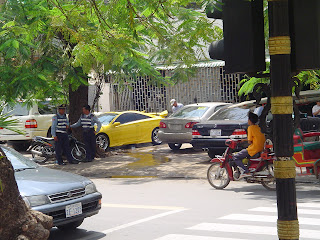Hardly any posts the last few days, partially due to the upcoming local elections of tomorrow. Why? Well, the printed and unprinted media focus all their resources on the campaigning. So hardly any news on traffic, unless you are interested in freakish accidents. Here, car kills motorcyclist (a hit and run), tuk-tuk which is bring body to victims home, gets involved in another accident. Well, this is hardly typical for Cambodia, so is it worth a mention?
However the media (in this case the Cambodia Daily of March 30, 2007) do report on lawlessness which is tolerated in the run-up to the elections.
Apparently the disregard to enforce this decree follows a request by Phnom Penh Municipal Police Chief to stop imposing fines from roughly two weeks ago. He wants
Handicap International, the NGO that takes on the traffic safety issue are not much of a help:
So that for the soundbytes from the media. Crossing Cambodia has been looking into the issue of using mobile phones and actively driving. In Asia it's quite customary not to turn your phone off, whatever the occasion, so it's little surprising that 1 in 10, 1 in 11 of car drivers drive and phone at the same time. The sample size was last week over 200, this week 143. Unfortunately Saturday morning is not a highly mobile phone traffic time so the average should assumed to be above 10%. That's quite a few. It is perceived to be banned in future but in the meantime nothing happens. What happens when one of these drivers crashes? Zilch! Who cares? Certainly not the traffic police they are only there toSo what's the difference between the parties:
However the media (in this case the Cambodia Daily of March 30, 2007) do report on lawlessness which is tolerated in the run-up to the elections.
'Rearview Mirror Laws Lifted for Election Period'.is the headline on an article. Untrue again, it was not a law but a municipal decree, which has less implications. Anyway for those of you who have been following the story on mirrors for motorcycles (postings here, here, here, here and here), this hardly comes as a surprise. The conclusion from these postings can be none other than that the decree has been disregarded for the last two months, so why the need to announce this officially?
Apparently the disregard to enforce this decree follows a request by Phnom Penh Municipal Police Chief to stop imposing fines from roughly two weeks ago. He wants
'to keep traffic flowing smoothly throughout the election period. "I do not want anybody to allege that traffic police stop party rallies by asking peoplefor money", he said. He added that anyone without mirrors would be fined once the election is over on Sunday'.Cryptically his deputy added:
'We don't force them to have mirrors, but people must know they are important'.Uhhh, so the whole act is simply to emphasize the potential importance of having mirrors? As enforcing mirrors is not the only traffic issue over which the traffic police rules, one must think about the need to enforce stoplights, driving on the right side, one-way streets. Are the traffic police only emphasizing their need as one of demonstrating their importance? Seems like the traffic police are trying to describe their job description as one whereby police hang around in the shade all day, emphasizing the importance of all and sundry and only using fines sort of to enforcement law when their needs need to be met.
Handicap International, the NGO that takes on the traffic safety issue are not much of a help:
'Mirrors help reduce accidents, ...'Again the simple fact that a motorcycle has a mirror leads to more accidents, not less; the need is to use mirrors, but as all Cambodian traffic users are customized to not using them, why enforce the need for them or stress the need to use them?
',... but the government should also inform people about the dangers of speeding, drink-driving and not wearing a helmet.'This is at best the briefest wish list one could make, there are many more issues that need to be tackled and foremost amongst these is the need to enforcement law.
So that for the soundbytes from the media. Crossing Cambodia has been looking into the issue of using mobile phones and actively driving. In Asia it's quite customary not to turn your phone off, whatever the occasion, so it's little surprising that 1 in 10, 1 in 11 of car drivers drive and phone at the same time. The sample size was last week over 200, this week 143. Unfortunately Saturday morning is not a highly mobile phone traffic time so the average should assumed to be above 10%. That's quite a few. It is perceived to be banned in future but in the meantime nothing happens. What happens when one of these drivers crashes? Zilch! Who cares? Certainly not the traffic police they are only there to
'inform people'.
 Norodom Ranariddh Party(NRP), former government ally, now opposition hopeful: some with mirrors, others not
Norodom Ranariddh Party(NRP), former government ally, now opposition hopeful: some with mirrors, others not Cambodian Peolpe's Party (CPP), the evergreen ruling party, has informed public of Letter of Intent to rule the rest of this century: no need for mirrors, because the traffic police are also CPP members!
Cambodian Peolpe's Party (CPP), the evergreen ruling party, has informed public of Letter of Intent to rule the rest of this century: no need for mirrors, because the traffic police are also CPP members! Sam Rainsy Party, most serious opposition party, form a threat to ruling CPP: must have mirrors at all times.
Sam Rainsy Party, most serious opposition party, form a threat to ruling CPP: must have mirrors at all times.All photo's reproduced from Khmer Intelligence Media Site










